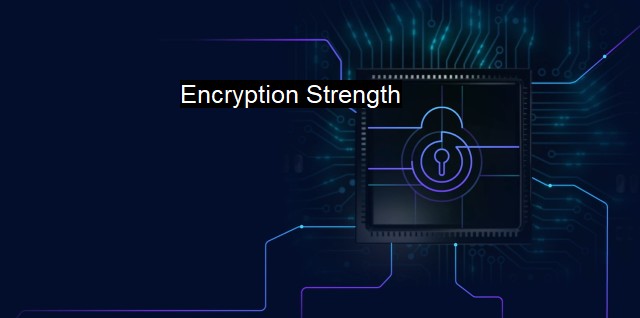What is Encryption Strength?
Exploring Encryption Strength: A Crucial Aspect of Cybersecurity and Antivirus Software for Data Protection
Encryption strength refers to the level of security provided by an encryption algorithm or protocol, which is often used by cybersecurity applications or systems to protect digital data. It is measured by the difficulty encountered in breaking the encryption, with advanced encryption techniques demanding significant computational power and time to decode. This crucial attribute is foundational in several sectors, such as antivirus programs, eCommerce, online banking, cloud data storage, secure email services, and many more.In a robust encryption system, the central pillar is mathematical algorithms. These algorithms use keys to encrypt and decrypt data. The keys are essentially long, random strings of characters that your device utilizes as a formula to scramble and unscramble information. How long the key is and how the key interacts with the encrypting algorithm collectively determine the encryption’s strength. That said, the length of the key used in the algorithm directly affects the encryption strength.
An algorithm using a key that's 128 bits long yields far more possible key combinations than a 64-bit key. Therefore, the 128-bit key provides a higher encryption strength than the 64-bit key, as it would require more resources to crack. Several encryption algorithms, such as its AES-128, AES-192, and AES-256 variants, have become the industry standard. The choice among these depends on the trade-off between the required level of security and the resources, time included, that organizations are willing to expend.
While key length alone may provide impressive numbers when it comes to potential key combinations, it's not the sole determinant of encryption strength. The algorithm’s overall design and implementation could allow other vulnerabilities besides brute force (key guessing) attacks.
For instance, a poorly implemented encryption algorithm could potentially introduce a critical flaw, enabling cybercriminals to bypass the encryption despite its theoretically vast number of possible keys. Examples of such vulnerabilities may include the ability to predict outcomes, reducing the actual number of possible key combinations, or a susceptibility to side-channel attacks, where attackers gather clues about the keys based on the system hardware's performance characteristics.
Cybersecurity systems, one among which is antivirus software, heavily rely on encryption to increase their usefulness. Antivirus software often applies encryption to secure user data and to shield its communication for remote administration or updates. Similarly, as many virus strains can deploy encryption to hide malicious activities, antivirus systems also employ decryption to analyze and address these threats effectively.
User credentials, including login information and even essential files like backup archives and logs, must give no chances for a data breach—thereby strengthening the need for encryption. Specifically, strong encryption methods become instrumental in antivirus programs that offer password management solutions and document protection services.
Modern encryption standards generally offer robust encryption strength, and few computational resources or theoretical advances seem likely to pose substantial risks to these standards; one possible forthcoming exception could be quantum computing. Quantum computers leverage the concepts of quantum physics, potentially making them capable of solving problems much faster than current technology. This increased computational power might enable them to break the encryption standards, posing a severe threat to them.
Therefore, while current relatively strong encryption methods are generally deemed secure from most practical threats, cybersecurity systems, antivirus programs included, must remain aware of and prepared for eventual advances in the world of quantum computing. The ongoing advancements of cyber threats make it a never-ending process to have an impeccable encryption method tested, audited, and put into use.
Encryption strength is jarringly significant in the cybersecurity sphere, shielding data from cyber threats. Maintaining strong, up-to-date encryption protocols, such as the ones antivirus systems extensively utilize, is a mission-critical task for anyone involved in protecting sensitive data from cyber threats. encryption strength should never be considered in isolation, and extra protective layers should be combined to ensure robust cybersecurity.

Encryption Strength FAQs
What is encryption strength?
Encryption strength refers to the level of protection that an encrypted message or file has against unauthorized access or decryption. It is measured in the number of bits in the encryption key, and a higher number of bits means stronger encryption.Why is encryption strength important in cybersecurity?
Encryption strength is crucial in cybersecurity because it determines how difficult it is for hackers and cybercriminals to break into a system or access sensitive information. Strong encryption makes it virtually impossible for attackers to decrypt data without the correct key, ensuring data confidentiality and privacy.How can I determine the encryption strength of my antivirus software?
Most antivirus software includes information about the encryption strength of their security features in their product specifications or user manuals. You can also check independent reviews and tests of the software's encryption capabilities to get a better idea of its strength.What is the recommended encryption strength for secure data storage?
The recommended encryption strength for secure data storage varies depending on the level of sensitivity of the data. Generally, a minimum of 128-bit encryption is recommended for personal and corporate data, while 256-bit encryption is ideal for high-security data storage environments such as military or government agencies.| | A | | | B | | | C | | | D | | | E | | | F | | | G | | | H | | | I | | | J | | | K | | | L | | | M | |
| | N | | | O | | | P | | | Q | | | R | | | S | | | T | | | U | | | V | | | W | | | X | | | Y | | | Z | |
| | 1 | | | 2 | | | 3 | | | 4 | | | 7 | | | 8 | | |||||||